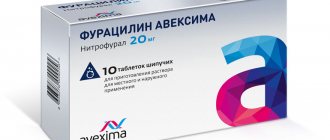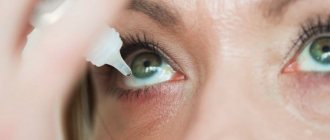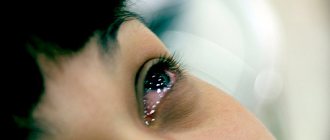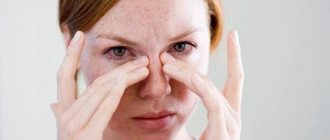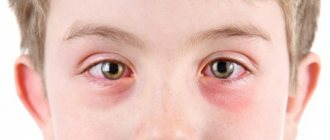What is conjunctivitis
Conjunctivitis is an inflammatory condition of the mucous membrane of the eye, which can be caused by pathogens of various origins - allergic reactions, viral, fungal or bacterial infections.
The main causes of conjunctivitis:
- Allergic reaction (to dust, medications, lenses, etc.);
- Bacteria (streptococcus, staphylococcus, pneumococcus and others);
- Virus (adenovirus, herpes);
- Fungus (candida, aspergillus);
- Poor hygiene;
- Diseases – acute respiratory viral infections, acute respiratory infections, sinusitis, tonsillitis, bronchitis and others;
- Vitamin deficiency.
Symptoms of conjunctivitis:
- Swelling of the eyelids;
- Swelling of the mucous membrane;
- Increased blood flow to the capillaries of the conjunctiva (hyperemia);
- Photosensitivity;
- Tearing;
- Redness of the white;
- Itching;
- Pain;
- Irritation;
- Discharge from the eyes (viscous, yellowish, gray, purulent);
- Feeling of sand.
The symptoms of viral conjunctivitis are slightly expanded:
- Formation of follicles;
- Serous discharge from both eyes;
- Clouding of the cornea.
A slit lamp examination is necessary to make a diagnosis. To accurately diagnose the type of conjunctivitis (its causative agent), a smear or scraping of the mucous membrane may be required.
Why is conjunctivitis dangerous?
The disease is accompanied by characteristic symptoms: redness and swelling of the eyes, itching and burning, photophobia, lacrimation, purulent or watery discharge. Many of those affected perceive conjunctivitis as a minor illness and are in no hurry to seek medical help. Meanwhile, untreated acute conjunctivitis can go into a chronic stage and in the future remind itself of itself under any stress affecting the body (hypothermia, colds, weakened immunity).
Also, conjunctivitis can develop into keratitis or a corneal ulcer, and if purulent secretion penetrates the eyeball, this can result in loss of vision. Therefore, when a pharmacist realizes that a pharmacy customer has not been to a doctor, he should strongly recommend that the customer visit an ophthalmologist.
Types of conjunctivitis:
- Bacterial, the causative agents of which are various bacteria: staphylococci, streptococci, chlamydia, hemophilus influenzae. The main symptom is discharge in the form of yellow or greenish pus. Treated with antiseptic and antibacterial eye drops.
- Viral, most often caused by adenoviruses1, but can also be caused by coronavirus and other viruses. Accompanied by colorless watery discharge. The basis of treatment is antiviral drops.
- Allergic, in which inflammation of the mucous membrane of the eyes occurs as a result of the body’s reaction to a particular allergen. Usually accompanied by other symptoms of hay fever. It is treated with antihistamines (drops and tablets), intranasal corticosteroids and sometimes cromoglycic acid.
- Conjunctivitis due to irritation: due to the use of cosmetics or contact with other irritants (solvents, paints, chlorine in swimming pools, etc.). Tear replacement drugs can be used for treatment, but the main thing here is to identify and eliminate irritating factors.
Diagnosis in each specific case should be carried out by a doctor. The nature of the disease will determine the ways of treating it, of which there are several. However, in any case, therapy is based on a combination of a number of components.
In the fight against conjunctivitis, the following can be used:
- Specific drugs that act on a specific pathogen.
- Anti-inflammatory (corticosteroids or NSAIDs).
- Means for preventing the development of secondary infection.
- Reparative drugs (for keratoconjunctivitis).
- Antiallergic drugs.
- Mydriatics (if there is a threat of developing iridocyclitis against the background of bacterial keratoconjunctivitis).
- Tear replacement drugs (at the end of the course of treatment).
Treatment
The allergic type of conjunctivitis does not require special therapy . It is necessary to find out the cause (irritant) and limit contact with it.
The viral type of conjunctivitis requires complex treatment, including the use of interferon drugs, antiviral eye drops and ointments. It is also necessary to add vitamin supplementation to restore weakened immunity.
Treatment of conjunctivitis symptoms involves the use of warm compresses and artificial tear drops.
For adenoviral conjunctivitis, the most effective is the use of Oftalmoferon , an antiviral, antimicrobial, anti-inflammatory, immunomodulating and regenerating drug. It is prescribed for both adults and children 5 to 8 times a day, 1-2 drops.
Treatment of conjunctivitis should begin at the very first signs. The neglect of inflammatory processes will negatively affect the quality of vision.
What are antibiotics and what are they?
Antibiotics (antibacterial, antimicrobial) eye drops are a topical drug that has a detrimental effect on pathogenic microorganisms that cause infectious eye diseases.
IMPORTANT! Antibiotics are not used for viral and fungal eye infections.
Indications for the use of antibacterial drops are:
- bacterial conjunctivitis;
- blepharitis;
- barley;
- keratitis;
- dacryocystitis;
- infectious ulcers of the cornea.
Antibiotics may also be prescribed for prophylaxis after surgery and eye injuries.
Classification
There are several types of eye drops for infection, but most often broad-spectrum antibiotics are prescribed.
Quinolones and fluoroquinolones
Quinolones are broad-spectrum antibacterial drugs that are aimed at inhibiting the activity of bacteria and microbes, i.e. have a bactericidal effect. These are synthetic drugs called DNA gyrase inhibitors. The active substance is introduced into the DNA of the pathogen and changes its structure, inhibits topoisomerase IV, disrupts DNA synthesis, due to which the microbe dies.
Quinolones are highly effective and can destroy even resistant, including multidrug-resistant strains of microorganisms.
This group of drugs includes non-fluorinated quinolones and fluoroquinolones. Non-fluorinated quinolones have a narrower spectrum of action and act predominantly on gram-negative bacteria.
IMPORTANT! Fluoroquinolones are not prescribed to children under 18 years of age or to pregnant women.
Fluoroquinolones appeared a little later. They have a more powerful bactericidal effect and more optimized pharmacokinetics. They are effective against staphylococci, gram-positive bacteria, intracellular pathogens, IV generation anaerobes and other microorganisms.
Macrolides
Macrolide antibiotics can be natural or semi-synthetic. They are low-toxic, cause almost no side effects, and have a mild effect on the body. At the same time, macrolides are highly therapeutically effective.
Macrolides have few contraindications and can be prescribed to children and, in some cases, to pregnant and lactating women.
Macrolides have a bacteriostatic effect, i.e. prevent the growth and reproduction of bacteria. They are active against gram-positive cocci, intracellular and membrane parasites.
Aminoglycosides
Aminoglycosides affect the contents of pathogen cells, i.e. penetrate through the membrane into the body of the microorganism and disrupt its vital functions. Antibiotics in this group are divided into three generations of drugs.
The first, the oldest, are less effective and more likely to cause side effects.
Modern third-generation aminoglycosides act very quickly, causing minimal harm to the body, and are also effective in combating microflora resistant to antibacterial therapy.
Levomycetins
Preparations based on chloramphenicol disrupt the process of protein synthesis in bacterial cells at the DNA and RNA level. This is the cheapest and most accessible group of drugs, with minimal side effects and therapeutic value.
Levomycetin is a synthetic drug.
Levomycetin preparations are effective against gram-positive and gram-negative bacteria, rickettsia, spirochetes and some viruses.
Acyclovir - what kind of medicine is it?
Acyclovir is an effective antiviral drug, the main purpose of which is to fight herpes infection. The effect of the drug is produced directly on the DNA of the virus, as a result of which its reproduction stops. The Epstein-Barr virus has an average effect. In addition, it has a strengthening effect on the body's defenses.
Acyclovir is produced in the form of:
- Tablets;
- Cream;
- Eye ointment;
- Lyophilisate.
Acyclovir eye ointment has the ability to be quickly absorbed by corneal epithelial cells and periocular tissues, while concentrating the drug in the intraocular fluid to suppress the viral pathogen.
A small reminder of the ointment application procedure:
- Thorough hand washing;
- We take a horizontal position (the head should be thrown back);
- Slightly pull back the lower eyelid;
- Squeeze out the ointment into a strip of 0.5 to 1 cm and place it behind the eyelid;
- Close the eye for a few minutes (to distribute the ointment over the eye);
- We remove the excess using cotton wool.
It is advisable to carry out such procedures before bedtime. You should absolutely not touch your eyes with your hands.
Side effects when taking Acyclovir:
- Nausea, vomiting, stool upset, abdominal pain (if taken orally);
- Headache, dizziness, sleep disorders, absent-mindedness;
- Mild burning, itching;
- Deterioration of vision;
- Chronic inflammation of the eyes;
- Quincke's edema (the most severe allergic side effect).
The drug is non-toxic and reacts directly to cells affected by the virus, without indiscriminately affecting everything.
Contraindications
The use of Acyclovir is prohibited in case of hypersensitivity to the components of the drug.
Acyclovir is used with caution during pregnancy and lactation, in the elderly and in patients with liver problems.
When treating conjunctivitis with Acyclovir, the most important thing is to correctly select the dose and its dose, and the hygienic aspect of eye care plays an important role.
Prevention
In order to prevent the occurrence of conjunctivitis in a 1-year-old child, the following preventive measures must be observed:
- Make sure that the baby does not touch his face and eyes;
- Wash your baby’s hands and face often;
- change clothes, towels and bedding regularly;
- include more fruits and vegetables in your diet;
- do not stop breastfeeding prematurely;
- protect your child from allergenic substances (dust, animal hair, smoke, etc.);
- regularly ventilate the room and do wet cleaning;
- visit doctors regularly;
- Protect your child from communicating with sick people.
It is also possible to avoid the development of conjunctivitis in childhood if you are examined and treated before birth, since a newborn often becomes infected while passing through the birth canal.
Author of the article: Kvasha Anastasia Pavlovna, specialist for the website glazalik.ru Share your experience and opinion in the comments.
Acyclovir for conjunctivitis in children
Treatment of this disease in children cannot be limited to basic eye washing. An integrated approach is needed here - the use of ointments, drops, oral antiviral drugs and immune-supporting drugs.
For conjunctivitis in children, taking Acyclovir orally (tablets) becomes mandatory when there is territorial growth or damage to the skin beyond the eye.
Reception nuances for children:
- The tablet version of Acyclovir is not prescribed to children under 1 year of age;
- Acyclovir ointment is approved for use in children over 1 month of age.
Recommended doses:
- Child 1-2 years old – half a tablet (100 mg) every 4 hours for 5 days;
- Child 2-5 years old – 1 (200 mg) or 2 (400 mg) tablets (according to the complexity of the course) four times a day;
- Children ≥6 years – 4 tablets (800 mg) four times daily.
Acyclovir in the form of an ointment is prescribed in a ratio of 80 mg per 1 kg of weight. Apply only to damaged areas of the skin every 4 hours for 5 days. If external manifestations have not passed during this time, the course of treatment is extended.
Drug treatment
How to cure conjunctivitis in a newborn? Trying to eliminate inflammation of the conjunctiva in a 1-year-old child on your own is not recommended, as this can lead to a worsening of the condition. Therapy for the disease should be selected by an experienced specialist after determining the form and cause of inflammation. Depending on the nature of the pathology, the following medications may be prescribed:
- Viral. Often this form of the disease goes away on its own after a few days. However, to avoid complications, it is not recommended to wait until the problem goes away. How to cure conjunctivitis in a 1 year old child? To alleviate the condition and speedy recovery, you can use the following antiviral drugs: Ophthalmoferon, Acyclovir, Albucid, Ganciclovir.
- Bacterial. Treatment of bacterial conjunctivitis in a child per year is carried out with a course of antibiotics. Ointments and drops with an antibacterial effect are selected, with a small dosage of the main active ingredient. The following drugs are most often prescribed: Albucid, Floxal, Tobrex, Levomycetin.
- Allergic. Often, to eliminate the symptoms of allergic conjunctivitis, it is enough to stop contact with the irritating substance. But if this cannot be done, then you can use the following medications: Allergodil, Zyrtec, Allomide, Dexamethasone.
All medications for children must be prescribed strictly by a doctor. It is strictly not recommended to use any medications on your own, even on the recommendations of friends and relatives. You should also not try to cure conjunctivitis in an infant using folk remedies without first consulting a specialist.
Acyclovir for conjunctivitis in adults
In most cases, adults are prescribed only ointment . In extremely advanced and complex cases, the use of Acyclovir orally is required.
It is recommended to apply the ointment to the lower conjunctival sac with a strip 1 cm long, five times per day. The interval between procedures should be on average 4 hours. The treatment regimen depends on the duration of the disease itself. You should not stop taking Acyclovir immediately after the disappearance of visible symptoms; you need to continue the manipulations for another three or four days.
Adults should take Acyclovir for conjunctivitis in the following dosage: 1 tablet five times a day. In this case, food intake is not important. You need to drink plenty of water.
Treatment will be effective if acyclovir is constantly in the blood; this requires its systematic use without temporary breaks.
Oxolinic ointment
A light yellow or white product based on oxonaphthylene. Nasal ointment is used exclusively topically to prevent influenza by preventing the penetration of viruses.
The product is effective against Herpes Simplex, adenovirus, herpes zoster, papillomavirus, and molluscum contagiosum. When used on the mucous membrane, only 20% of the components are absorbed.
Suitable for use even during breastfeeding, pregnancy, and children under 2 years of age with caution and after medical consultation.
Release form and composition
The ointment is released in a metal tube. The package contains 10 grams of the drug. The concentration of the main substance in the composition is 0.25%.
Components of the drug:
- Dioxotetrahydroxytetrahydronaphthalene 0.0025 g. An antiviral component that destroys various strains of viruses, blocking their replication in infected cells. In this regard, the virus stops producing enzymes and dies. When applied topically, the ingredient is poorly absorbed and does not accumulate in the mucous membrane and tissues.
- Vaseline up to 1 gram. The ingredient forms a protective film and has a moisture-retaining effect. Prevents the occurrence of infections and inflammations. It has virtually no contraindications. Not absorbed into the blood.
- Lemon acid.
- Paraffin.
Indications for use
Oxolinic ointment has found application in the treatment of viral infections and the prevention of infections and viruses. Used in the treatment of the following diseases:
- viral rhinitis and other viral diseases of the nasal mucosa;
- adenoviral, herpetic eye lesions: keratoconjunctivitis, keratitis, conjunctivitis;
- psoriasis;
- simple, blistering lichen;
- molluscum contagiosum;
- inflammation of the eyeball;
- common warts, flat warts, spiny warts, genital warts;
- herpes simplex;
- shingles;
- dermatitis herpetiformis;
- prevention of viral infections, influenza during seasonal epidemics.
Oxolinic ointment for eyes
According to Russian and Ukrainian standards, oxolin is allowed for the treatment of eye diseases. Indications include viral eye diseases. In the absence of better remedies, for example, Levomekol, ointment with oxoline can be used for barley on the eye.
In Belarus, oxolinka is not used for these purposes, and the instructions in the indications section do not include eye diseases.
For eye inflammation, the use of oxolinic ointment is more justified, in contrast to antibacterial agents. The reason is that the eyes are often affected by viruses, not bacteria. The antibiotic will not have a therapeutic effect against conjunctivitis and keratitis.
Oxolinic ointment can be used on the mucous membrane of the eyes at a concentration of 0.25%. Please note that 3% oxolinka is used only for the treatment of skin diseases.
In what cases is Oxolinic ointment effective?
The effectiveness of Oxolinic ointment is high for viral lesions and associated inflammation.
The medication has a therapeutic effect in cases of papillomavirus, adenovirus, herpes zoster, psoriasis, molluscum contagiosum, Herpes Simplex, and herpes zoster.
Instructions for use
Please note that the instructions for use of Oxolinic ointment allow only external use.
For the treatment of eye diseases, it is used in an amount commensurate with a pea, which is placed behind the eyelid. Grasp the lower eyelid with your fingers, pull it down, and apply the product. With your eyes closed, move your pupils in all directions for a minute so that the product spreads evenly over the eyeball. Apply once every 6-8 hours. The course of treatment depends on the type of disease and is discussed with the doctor. Usually it does not exceed fourteen days.
As a preventive measure against influenza, a tampon is moistened in oxolinka and distributed in a small layer over both nostrils. It is used for these purposes 2-3 times a day during the entire period of the epidemic or in the first 3-4 days of your loved ones’ illness.
Oxolinic ointment for children
The drug is poorly absorbed (up to 20%), so it is relatively safe even for children. The instructions for the drug state that the product can be applied to the mucous membranes of a child with caution.
The ointment may cause temporary burning or discomfort in the eye, but this sensation goes away within a few minutes. In this regard, you can choose another medication for the child, if possible.
Contraindications
It is not recommended to use Oxolinic ointment during pregnancy and lactation, but in general, use is permissible under medical supervision and with caution.
The use of the product in case of individual hypersensitivity to oxoline or petroleum jelly is strictly prohibited.
Side effects
In rare cases, the drug may cause side effects with the following symptoms:
- irritation;
- redness;
- burning.
The symptoms disappear within the first two minutes. If this does not happen, rinse your eyes with running water. The product does not affect eye pressure.
Precautionary measures
If after 1-2 days of use swelling of the mucous membrane, redness, burning in the eye area occurs, you must stop treatment with the ointment and consult a doctor.
